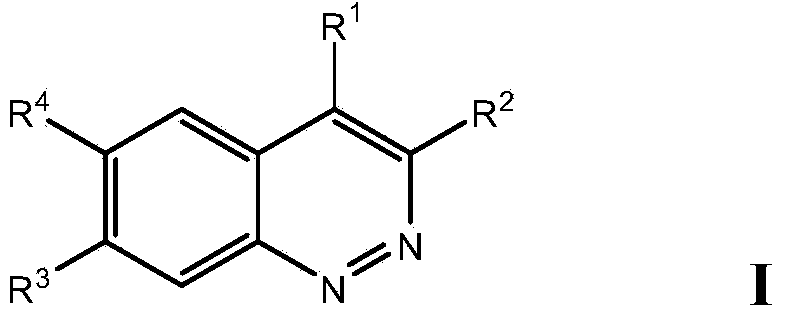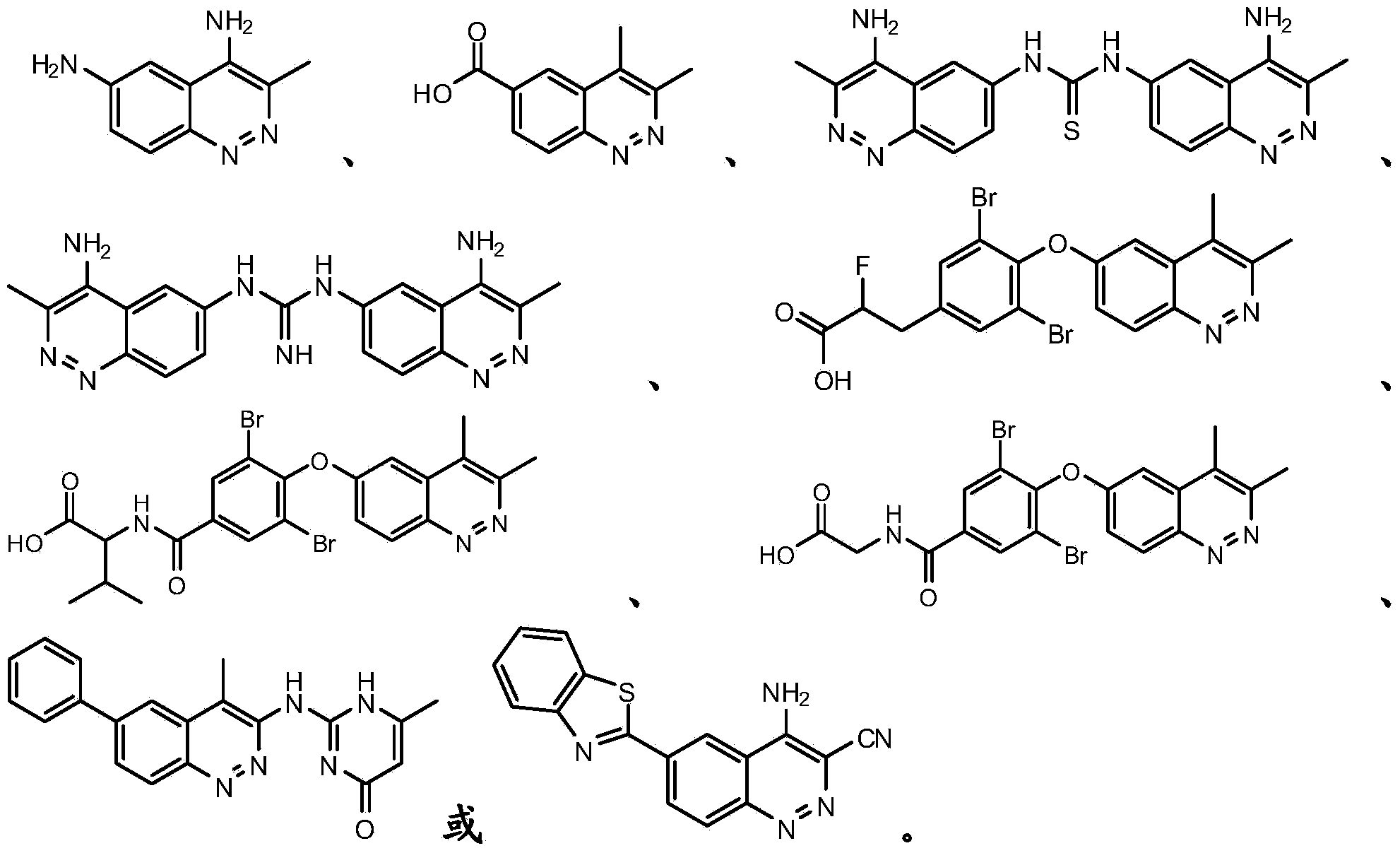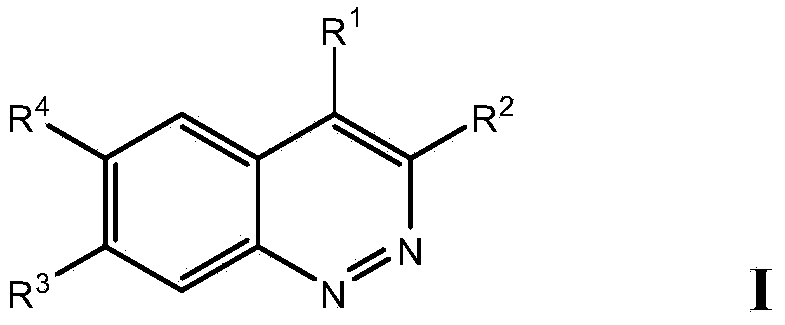Inhibitors of LRRK2 kinase activity
A technology of -CR5R6R7, -OR9, applied in the field of inhibitors of LRRK2 kinase activity
- Summary
- Abstract
- Description
- Claims
- Application Information
AI Technical Summary
Problems solved by technology
Method used
Image
Examples
Embodiment 1
[0632]Synthesis of 4-amino-7-(4-(methylsulfonyl)phenyl)cinnoline-3-carboxamide (5)
[0633] 4-Amino-7-(4-(methylsulfonyl)phenyl)cinnoline-3-carboxamide (5) is prepared from 3-chloroaniline (1) in the following 3 steps:
[0634]
[0635] Step 1- Synthesis of 2-((3-chlorophenyl)diazenyl)-2-cyanoacetamide (2): 3-chloroaniline (1,7.4g, 58.1mmol ), and 15 mL of concentrated HCl was slowly added, followed by 10 mL of water to give a slurry. Sodium nitrite (4.0 g in 15 mL of water, 58.1 mmol) was added at 0°C. After stirring at 0 °C for 15 min, a solution of sodium acetate (19.1 g, 232 mmol) and cyanoacetamide (4.89 g, 58.1 mmol) in 85 mL of water and 60 mL of ethanol was added slowly using an addition funnel. After the addition was complete, the ice bath was removed and the suspension was slowly warmed to 23 °C and stirred for 16 h. The desired material was isolated by filtration and washed with water, ethanol and Et 2 Rinse with O, then dry under vacuum to obtain the desired...
Embodiment 2
[0650] 4-(isopropylamino)-7-(4-(methylsulfonyl)phenyl)cinnoline-3-carboxamide (17) and 4-(isopropylamino)-7-(4-(methylsulfonyl) Synthesis of sulfonyl)phenyl)cinnoline-3-carbonitrile (18)
[0651] 4-(Isopropylamino)-7-(4-(methylsulfonyl)phenyl)cinnoline-3-carboxamide is prepared from 3-iodoaniline (10) in 6 or 7 steps as follows (17) and 4-(isopropylamino)-7-(4-(methylsulfonyl)phenyl)cinnoline-3-carboxamide (18):
[0652]
[0653] Synthesis of step 1-2-cyano-2-((3-iodophenyl)diazenyl)acetamide (11): 3-iodoaniline (10, 12.7g, 58.1mmol ), and reacted similarly to step 1 of Example 1 to obtain the desired compound (11,70%).
[0654] Synthesis of step 2-4-amino-7-iodocinoline-3-carboxamide (12): 2-cyano-2-((3-iodophenyl)diazenyl)acetamide is filled into a 20mL reaction bottle (11,1 g, 3.2 mmol), and suspended in 13 mL of toluene. Add 5 spoonfuls of AlCl 3 , and seal the vial under nitrogen. The heterogeneous reaction mixture was heated to 150 °C for 20 min using microwave ...
Embodiment 3
[0842] Synthesis of N-isopropyl-7-(4-(methylsulfonyl)phenyl)-3-(thiazol-4-yl)cinnolin-4-amine (70)
[0843] N-isopropyl-7-(4-(methylsulfonyl)phenyl)-3-(thiazole-4- base) cinnolin-4-amine (70):
[0844]
[0845] Synthesis of step 1-4-bromo-2-nitrobenzoyl chloride (60): 4-bromo-2-nitrobenzoic acid (59,10g, 40.6mmol) was dissolved in 133mL THF, and the resulting solution was Cool to 0 °C. Oxalyl chloride (7.09 mL, 81.3 mmol) was added over 5 minutes, followed by 2 drops of DMF, and the reaction mixture was heated to reflux for 3 hours, after which time the solution was concentrated and dried under vacuum to afford the desired compound 60.
[0846] Step 2- Synthesis of 2-(4-bromo-2-nitrobenzoyl) diethyl malonate (61): Diethyl malonate (6.16mL, 40.6mmol) was dissolved in 50mL THF, And the resulting solution was cooled to 0 °C. Sodium hydride (1.94 g a 60% suspension, 48.7 mmol) was added in portions over 30 minutes and the resulting mixture was heated to reflux for 2 hours. ...
PUM
 Login to View More
Login to View More Abstract
Description
Claims
Application Information
 Login to View More
Login to View More - R&D
- Intellectual Property
- Life Sciences
- Materials
- Tech Scout
- Unparalleled Data Quality
- Higher Quality Content
- 60% Fewer Hallucinations
Browse by: Latest US Patents, China's latest patents, Technical Efficacy Thesaurus, Application Domain, Technology Topic, Popular Technical Reports.
© 2025 PatSnap. All rights reserved.Legal|Privacy policy|Modern Slavery Act Transparency Statement|Sitemap|About US| Contact US: help@patsnap.com



